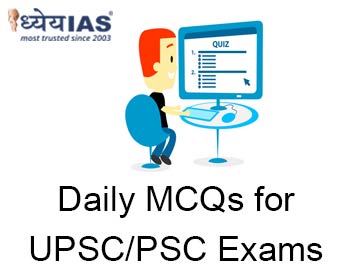Home > Daily-mcqs
Daily-mcqs 26 Mar 2025

Q1:
Match the following key judicial provisions with their respective functions: Judicial Provision Purpose A. Article 50 1. Supervision of subordinate courts B. Article 235 2. Removal of High Court judges C. Article 124(4) 3. Separation of judiciary from the executive D. Article 217 4. Removal of Supreme Court judges
Which of the above pairs are correctly matched?
A: A-1, B-2, C-3, D-4
B: A-3, B-1, C-4, D-2
C: A-2, B-3, C-1, D-4
D: A-4, B-3, C-2, D-1
Answer: B
Explanation:
Q2:
Consider the following statements: Statement-I: The Judicial Standards and Accountability Bill aims to improve transparency and accountability in the judiciary. Statement-II: The Bill has been enacted and is actively ensuring judicial accountability in India. Which of the following is correct?
A: Both Statement-I and Statement-II are correct, and Statement-II is the correct explanation for Statement-I.
B: Both Statement-I and Statement-II are correct, but Statement-II is not the correct explanation for Statement-I.
C: Statement-I is correct, but Statement-II is incorrect.
D: Statement-I is incorrect, but Statement-II is correct.
Answer: C
Explanation:
Statement-I: The Judicial Standards and Accountability Bill aims to improve transparency and accountability in the judiciary.
Statement-II: The Bill has been enacted and is actively ensuring judicial accountability in India.
Q3:
Consider the following statements regarding the IMF’s assessment of India’s financial system: 1. India’s financial system is diverse and interconnected, consisting of state-owned financial institutions, private banks, and NBFCs. 2. Public sector banks (PSBs) in India are fully capitalized and do not require additional strengthening of their capital base. 3. India’s insurance sector has shown strong growth, supported by enhanced regulations and digital innovations. How many of the above statements are correct?
A: Only 1
B: Only 2
C: All three
D: None
Answer: B
Explanation:
Thus, only two statements are correct, making (b) the right answer.
Q4:
Q4. Consider the following statements regarding India's defence sector growth under the Make in India initiative: 1. Indigenous defence production in India reached ₹1.27 lakh crore in FY 2023-24, marking its highest-ever growth. 2. Defence exports have increased from ₹686 crore in FY 2013-14 to ₹21,083 crore in FY 2023-24, a nearly 30-fold rise. 3. The Defence Industrial Corridors (DICs) are located in Maharashtra and Karnataka to boost defence manufacturing. How many of the above statements are correct?
A: Only 1
B: Only 2
C: All three
D: None
Answer: B
Explanation:
Q5:
Consider the following statements regarding permafrost in the Kashmir Himalayas: 1. Permafrost is ground that has remained frozen for at least two years. 2. In Jammu & Kashmir and Ladakh, permafrost covers approximately 64.8% of the total geographic area. 3. Permafrost degradation has no significant impact on water availability in the region. How many of the above statements are correct?
A: Only 1
B: Only 2
C: All three
D: None
Answer: B
Explanation:
Thus, only two statements are correct, making (b) the right answer.
Q6:
Consider the following statements regarding permafrost in the Kashmir Himalayas: 1. Permafrost is ground that has remained frozen for at least two years. 2. In Jammu & Kashmir and Ladakh, permafrost covers approximately 64.8% of the total geographic area. 3. Permafrost degradation has no significant impact on water availability in the region. How many of the above statements are correct?
A: Only 1
B: Only 2
C: All three
D: None
Answer: B
Explanation:
Thus, only two statements are correct, making (b) the right answer.